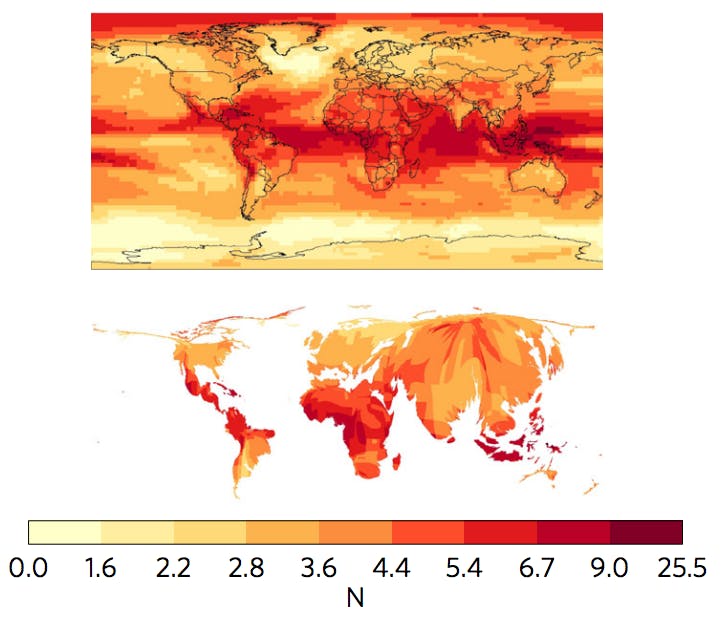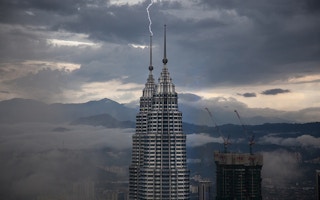Using a measure of climate ‘familiarity,” the researchers show that the tropics in particular are likely to experience conditions that are virtually unheard of for the region in the present climate.
But keeping global temperatures rise below 2C above pre-industrial levels could help keep the climate “familiar” within this century, the researchers say. That means people alive today could see the benefits of mitigation within their lifetimes.
Signal-to-noise
While climate change research often focuses on how many degrees temperatures have warmed or the projected change in annual rainfall, a relatively recent approach is to consider the “time of emergence.”
The weather we experience every day is a combination of the long-term trend of climate change – the “signal” – and the short-term fluctuations of natural variability – the “noise”. The time of emergence is the point when the signal becomes clear above the noise.
Taking this idea in a slightly different direction, the new Nature Climate Change study focuses on the magnitude of emergence, rather than the time. In other words, showing how much future climates are going to differ from the highs and lows that people currently experience.
This approach can help pinpoint where climates are likely to change beyond what people have to cope with at the moment, says lead author Dr Dave Frame, director of the New Zealand Climate Change Research Institute at Victoria University of Wellington. He tells Carbon Brief:
“A couple of degrees of warming in a place which is used to lots of climate variability is likely to be easier to cope with than the same level of warming in a place which is used to a really regular climate.”
Carbon Brief spoke to another of the study’s authors, Dr Manoj Joshi from the University of East Anglia, about the study at the recent European Geosciences Union General Assembly in Vienna. You can see him explaining the findings in the clip below.
Unfamiliar, unusual and unknown
Using climate models, the researchers calculated signal-to-noise ratios – i.e. the change in average temperature divided by the year-to-year variability – for future temperatures across the world. The higher the resulting score, the more unfamiliar future climates are likely to feel for the people in that region.
“
It’s quite a powerful message to say ‘your actions will affect your world that you will see in the future. You will be alive to see the benefits of mitigating – of lowering – carbon emissions’.
Manoj Joshi, University of East Anglia
The researchers then classified projections of temperature change in terms of how unfamiliar the climate is expected to become.
They came up with three categories, for when the signal-to-noise ratio hits one, two or three, respectively: An “unusual” temperature is one that people would experience once every six years or so under the baseline climate of 1986-2005.
An “unfamiliar” temperature would be one that would only occur once every 44 years. Finally, an “unknown” temperature would be virtually unheard of in the present climate, occurring once every 740 years.
You can see some of their results in the maps below for a moderate emissions scenario called RCP4.5. It’s worth noting that current emissions are tracking above RCP4.5, close to the highest emissions scenario used by the Intergovernmental Panel on Climate Change (RCP8.5).
The upper map shows the signal-to-noise ratios for temperature by the end of the century. The darker the shading, the more unfamiliar the climates are expected to become.

Maps show emergence of new climates under the RCP4.5 emissions scenario for the end of the century for a standard map (upper) and population-weighted cartogram (lower). Shading indicates the signal-to-noise ratio (the darker the shading, the higher the ratio). Maps show results for the median of all the climate model simulations. Source: Frame et al. (2017)
The results suggest that by the 2030s, around half of the global population can expect to experience “unfamiliar” climates (compared to 1986-2005), and “unknown” climates by mid-century. By 2100, only 20 per cent of the world’s population would avoid living in “unknown” climates, the paper says.
The results also show that tropical regions are likely to experience the most dramatic changes to the familiarity of the climate. These areas, which include Malaysia, Indonesia, western India, West Africa and Central America, are home to almost half of the world’s population.
You can see this in the lower map (above), which shows the same signal-to-noise values, but where the size of the land areas is distorted to represent the size of the population affected.
While other places might experience higher absolute temperature change, the impacts will be felt more keenly in the tropics, Joshi explains:
“Even though the temperature change they experience is less than than might be experienced in the Arctic, compared to the variability that people have seen in the past, this change is actually a very big deal.”
‘Powerful message’
Using signal-to-noise rather than simple temperature change also provides another way to consider mitigating climate change, the paper says:
“We suggest that a key measure of successful mitigation should involve keeping climate as ‘familiar’ as possible.”
Their results suggest that under the lowest emissions scenario – broadly equivalent to a world no more than 2C warmer than pre-industrial levels – unknown climates are avoided for much of the world.
This shows that cutting emissions now can prevent some large changes in the signal-to-noise ratio of future temperature, says Frame. These benefits could be felt within the lifetimes of people alive today, he adds:
“For a young adult in Indonesia, Colombia or Nigeria today, the results show that mitigating from a high carbon path to a low carbon path can keep the climate they experience in late life at least a bit similar to those they enjoyed in their young days.”
This is a compelling way to incentivise people to cut emissions, says Joshi:
“It’s quite a powerful message to say ‘your actions will affect your world that you will see in the future. You will be alive to see the benefits of mitigating – of lowering – carbon emissions’.”
In fact, this is the most important finding from their study, says Frame:
“Too much of the climate conversation implies that mitigation is something that has benefits for people in the distant future – we’re showing that many of the beneficiaries are alive today, working and paying taxes.”
This story was published with permission from Carbon Brief.










